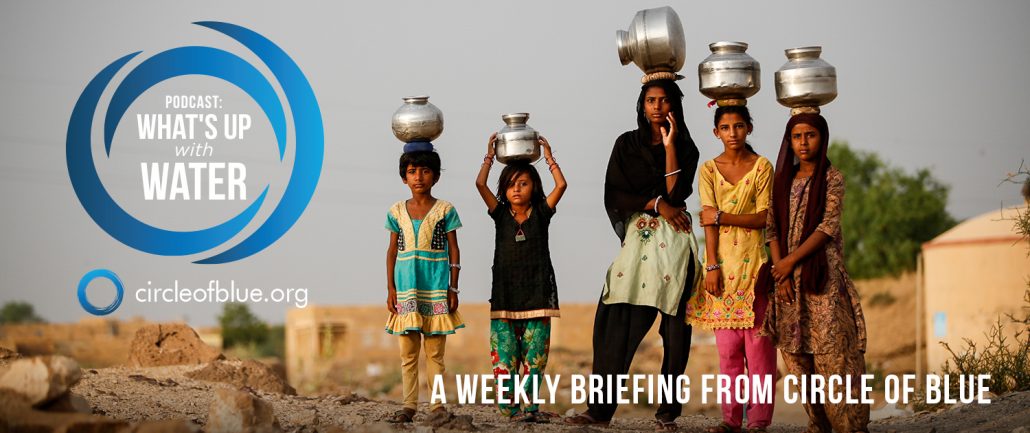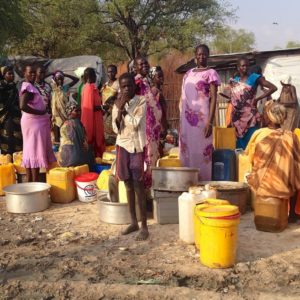Transcripts
What’s Up With Water for April 23, 2018
I’m Eileen Wray-McCann, for Circle of Blue, and here’s What’s up with Water, a condensation of the world’s water news.
Circle of Blue’s Brett Walton is in Cape Town this week to report on the city’s water crisis. Even though the city has backed away from threats to turn off water to most homes and businesses this year, residents still cope with intermittent outages and reduced pressure in the pipes.
Water has stopped flowing several times since February at the LEAP school in the Philippi district of Cape Town. Two hundred-fifty students in grades eight through twelve attend LEAP. Nasreen Abrams, one of the school’s leaders, said the outages disrupt learning time for her students. Look for more of Walton’s dispatches and feature reporting from Cape Town in the weeks to come.
———————————
In Australia, about half the land in the Northern Territory will be opened to fracking, after the territorial government lifted a ban. The Guardian reports that petroleum companies are expected to begin exploratory drilling early next year. The government saysrules will be strict, but critics contend that water supplies are still vulnerable.
Ministry officials touted the creation of jobs, and pointed to an independent report asserting that risks from hydraulic fracturing could be managed. The government accepted all of the report’s recommendations, such as keeping 49% of the territory free from fracking. Protected areas include national parks, conservation areas, indigenous areas, residential property, and places of cultural, environmental and tourist value.
Environmentalists and scientists find the decision premature and irresponsible. They are pressing the Labor government to uphold the fracking moratorium to safeguard water, land and public health. The national government has encouraged the northern territory to allow resource development, which critics view as pressure aligned with the interests of the gas industry. According to the Australia Institute, a public policy think tank, fracking would substantially increase Australia’s carbon emissions, crippling current efforts to curb climate change.
———————————
Water levels in Nigeria’sGoronyo dam have fallen to 10 percent of capacity, jeopardizing the water supply of 2 million people.
Rationing is in effect and water trucks are delivering to major towns. However, many communities have no choice but to risk using untreated water.
The Goronyo dam basin in the northern part of the country has long supplied water for farming, fishing and residents. But over the past year there has been a dramatic change: the irrigation channels are dry, and the surrounding fields are parched. Most farmers have given up.
Although there has been an increase in rainfall in the area over the last decade, it has not kept pace with rising temperatures, which have magnified evaporation. Failing supplies are also threatened by poor management practices and inadequate maintenance.
———————————
Al Jazeera reports that water privatization continues to face pushback in the European Union. Between 2000 and 2015, there were 235 recorded cases of water management being returned to municipalities in 37 European countries. Over 100 million people have been affected by the change.
Of those cases, 40% were in France, once known as a leader in privatization. In 2010, after 25 years of private management, Paris dropped contracts with two of the world’s largest water companies, largely due to fraud, scandals and lack of maintenance. Officials expressed the concern that companies were putting put profit before the welfare of people.
Berlin had a similar scenario.
Yet opponents of privatization in some EU countries feel excluded from the shift. Activists in Greece, Portugal, Italy and Ireland argue that the EU continues to pressure these member countries to privatize through conditions in loan agreements or economic assistance plans.
Al Jazeera reports that two million citizens from 13 European Union countries have urged the European Commission to remedy this by recognizing water as a human right, as the United Nations did in 2010. Thus far, they have not been successful.
———————————
Almost two years after chemicals from a U.S. airbase were found in wells in Colorado, the military has announced new efforts to remediate the damage.
The chemicals, called PFAS, came from firefighting foam used at Peterson Air Force Base. They are linked to cancer and other health problems, and they leached into an aquifer in southern El Paso County, affecting three utility systems and about 69 thousand people.
The pollution made headlines in 2016 with an EPA health advisory, and at the time, the Air force promised $4.3 million to address the contamination, buying bottled water and filtration systems.
Last week, the Air Force pledged an additional $900,000 to buy clean water and maintain filters. The new funds are also targeted for ongoing contamination problems and for easing water delivery costs. Long-term remediation is not expected for years.
Current studies are evaluating the health damage from Peterson Air Force base. According to an investigation by the Colorado Springs Gazette, the military had internal studies dating to the 1970s showing that chemicals in their firefighting foam were toxic. Yet it continued to be used around the world for decades, contaminating hundreds of military in the U.S. alone. Over 7,000 water users in southern El Paso County have joined a suit against the companies that made the firefighting foam, which was eventually banned by the military.
———————————
And that’s What’s Up With Water…We’d like to share what’s up where you are – Tweet us with your water news: @circleofblue hash tag whatsupwithwater.
Eileen Wray-McCann is a writer, director and narrator who co-founded Circle of Blue. During her 13 years at Interlochen Public Radio, a National Public Radio affiliate in Northern Michigan, Eileen produced and hosted regional and national programming. She’s won Telly Awards for her scriptwriting and documentary work, and her work with Circle of Blue follows many years of independent multimedia journalistic projects and a life-long love of the Great Lakes. She holds a BA and MA radio and television from the University of Detroit. Eileen is currently moonlighting as an audio archivist and enjoys traveling through time via sound.





